Macedonia’s Skopje, one of the least well-known capital cities in Europe, is marking ten years since it went through an unusual building project designed to recapture its national identity.
Right in the middle of Skopje stands a 22-meter-high bronze middle finger directed towards Greece. It towers above the city, glinting in the sun, dwarfing everything else in Plostad Makedonija’s central square.
“This is our way of saying [up yours] to them,” one-time foreign minister Antonio Milososki said of the magnificent edifice.
The finger is not literally a finger but a metaphor in the form of a statue of North Macedonia’s most famous son, Alexander the Great—an ancient hero at the center of the former Yugoslavian nation’s decades-long fight with Greece for its name. Like much in the small southeastern European city, it is not what it first seems.
Initially, Alexander looks much like the classical buildings and statues that populate North Macedonia’s ancient rival to the south. In fact, he is just ten years old, not 3,000. Alexander was one of 136 structures built at the eye-watering cost of more than $700 million as part of a hugely controversial “antiquiziation” project by the former VMRO-DPMNE government called Skopje 2014.
Recommended Fodor’s Video
A decade on, with many of the statues already cracking and falling apart, it is either a source of great pride or utter shame, depending on which North Macedonian you’re asking.
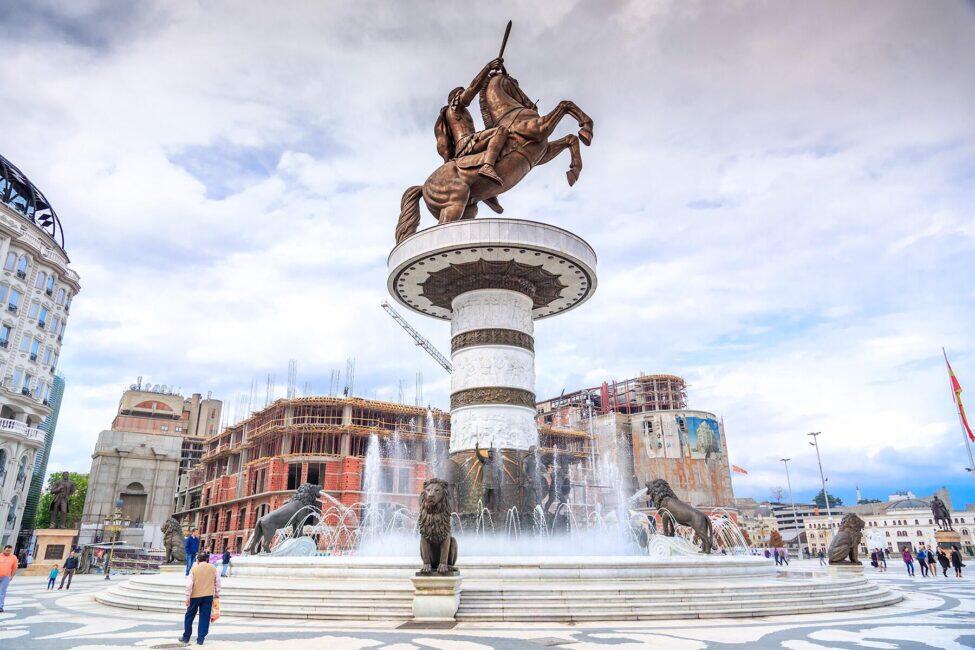
Defending the Statues
In defense of Skopje 2014, it has put the city on the map. Aphrodite Debouse runs a Balkan Explore Us tour company in the city and has lived in Skopje her whole life. When she started out, only the odd backpacker made it there. Those who did were nonplussed by the concrete landscape they found.
Fifty years ago, Japanese architect Kenzo Tange set about making Skopje unbreakable after a 1963 earthquake flattened 80% of the city. He was successful, but the price was a level of brutalism quite staggeringly bleak, even by Eastern Bloc standards. It helped Skopje earn the title of Europe’s least visited capital and hold onto it for decades. Today, as many as 3 million tourists visit the city of 600,000 each year.
“People in tourism love Skopje 2014,” Debouse tells me from her shop close to the central square. “We had no tourism before, and now more and more people are coming.”
Debouse meets groups of these visitors in front of the large Marriott Hotel and takes them first to the Memorial House of Mother Theresa, explaining that the saint spent her first 18 years in the city. There is a statue of the now somewhat controversial Catholic in front of the house–a replica of the original destroyed in the earthquake. From there, they’ll head to the partially-flattened now-rebuilt train station, which has become the city’s main museum. Next, the group troops across the River Vardar over the 600-year-old Stone Bridge, which is the main icon on Skopje’s coat of arms and a place of frequent public executions across the years. In 1689, poor locals had to watch as an anti-Ottoman rebel was skewered on a pole in the city’s old bazaar. The group ends up in the central square, surrounded by the statues.
Another defender of their construction is Cvetin Chilimanov, a conservative commentator who believes it was a crucial part of the country’s renaming in 2018 from the Former Yugoslav Republic of Macedonia to what it is today.
“Our neighbors were very hostile to the idea we were there. The Greeks had a virulent reaction to Macedonian independence, and they tried to suffocate the country at birth.” He says the four-year project got builders working post-2018 crash and showed the world North Macedonians “would not be bullied” into choosing a different name, as the Greeks had demanded.
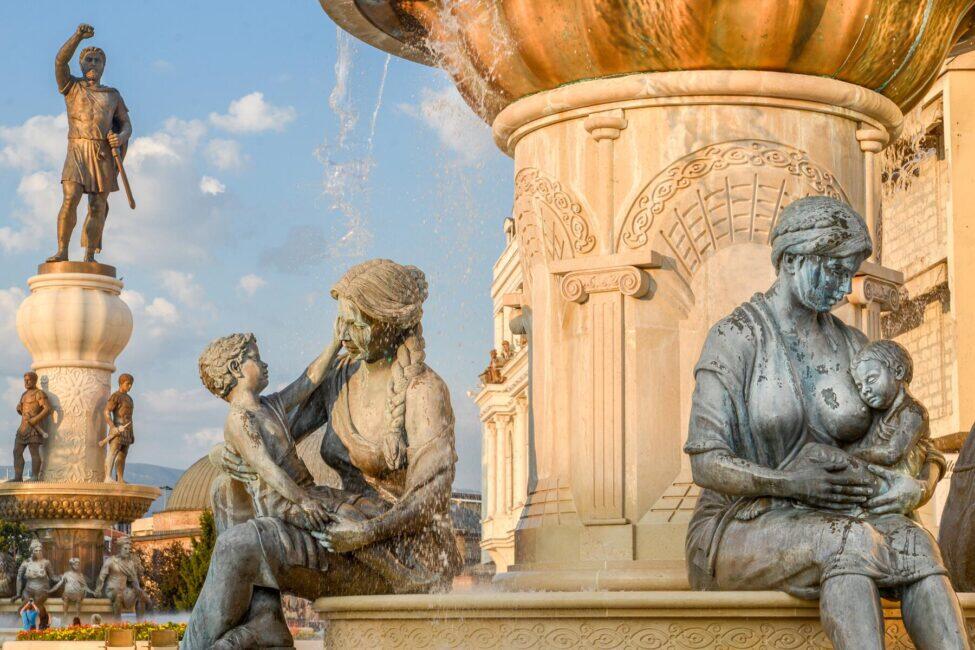
In Opposition to Skopje 2014
Others are less convinced. One reason why is that some of the statues are baffling. A large molded figure of a begging man, which cost €1 million ($1.07 million), stands close to a young girl in a miniskirt holding a phone. The likeness of a shoe shiner, which cost €1.5 million ($1.61 million), polishes eternally nearby. “It is without any sense,” Debouse admits.
The manner in which the statue of Alexander is flanked by numerous, increasingly obscure members of his family leads locals to joke that they just paid their respects at the plinth of his third cousin once removed.
Walk around the center, and a nagging sense of deja vu may be added to the bafflement. This is thanks to the way former Prime Minister Nikola Gruevski (a.k.a. Mr. Cut and Paste) found very direct inspiration for Skopje 2014 in his world travels. Versions of the Arc de Triomphe, the White House, and the Pantheon are all there to see. “Thank god he didn’t go to Egypt and bring the pyramids back,” Debouse jokes.
The laughter stopped a long time ago for those on the left who accuse Gruevski of fraudulently wasting hundreds of millions on the project. They hit the streets in 2016 in what is now known as the Colorful Revolution to call out alleged corruption. The protesters focused their rage on the statues, turning them into splattered rainbows by launching filled balloons from catapults.
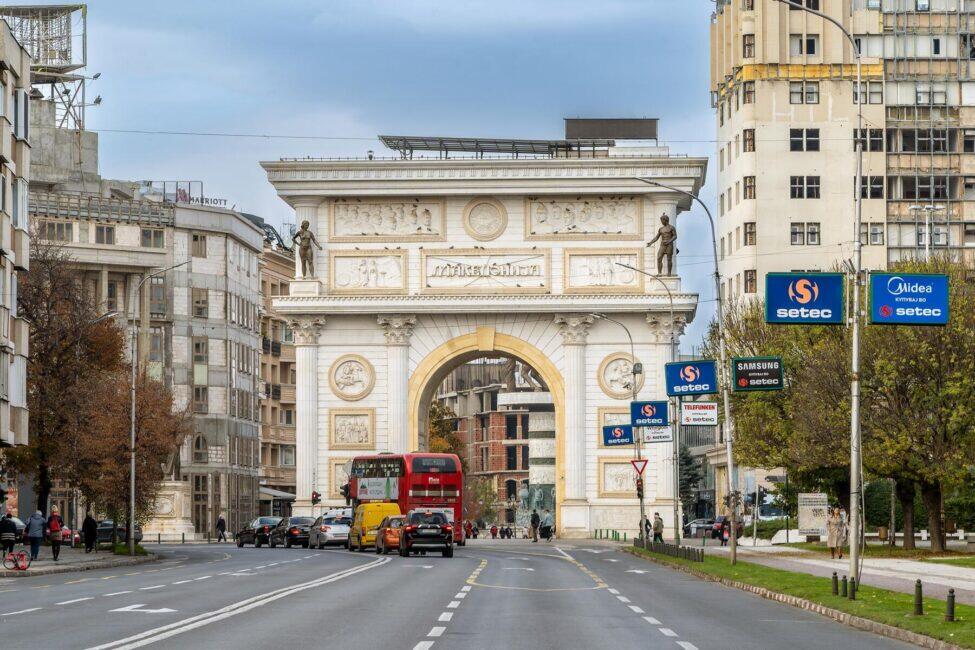
Branimir Staletovic, an academic who studies protest movements at Karl-Franzens-Universität Graz, explained: “The statues of Skopje 2014 were then the main targets of the protesters, who were throwing paint on the objects, viewing them as symbols of the authoritarian government.”
Eight years on some of the paint marks have been allowed to remain by the left-wing administration now in charge. It is a poignant reminder of the former lot’s failings. The paving slabs are cracked. The concrete of the baroque facades atop brutalist buildings is clearly part Styrofoam. A bucket stands in the leaking Macedonian National Theatre. Police officers are constantly on guard around the fountain beneath Alexander’s feet to prevent homeless people from washing in it while a backdrop of Wagner and American Christmas songs waft out from speakers atop golden lampposts.
“It is a project that costs almost $700 million, which is a large amount for a poor country like North Macedonia. That money could have been used to build hospitals, kindergartens, schools, highways,” journalist Vasko Magelov tells me.
The other main argument about Skopje 2014 is that it’s a big distraction. It may be kitsch and even funny from the outside, but the gothic edifices are also obscuring and stealing attention from what is a fantastic city.
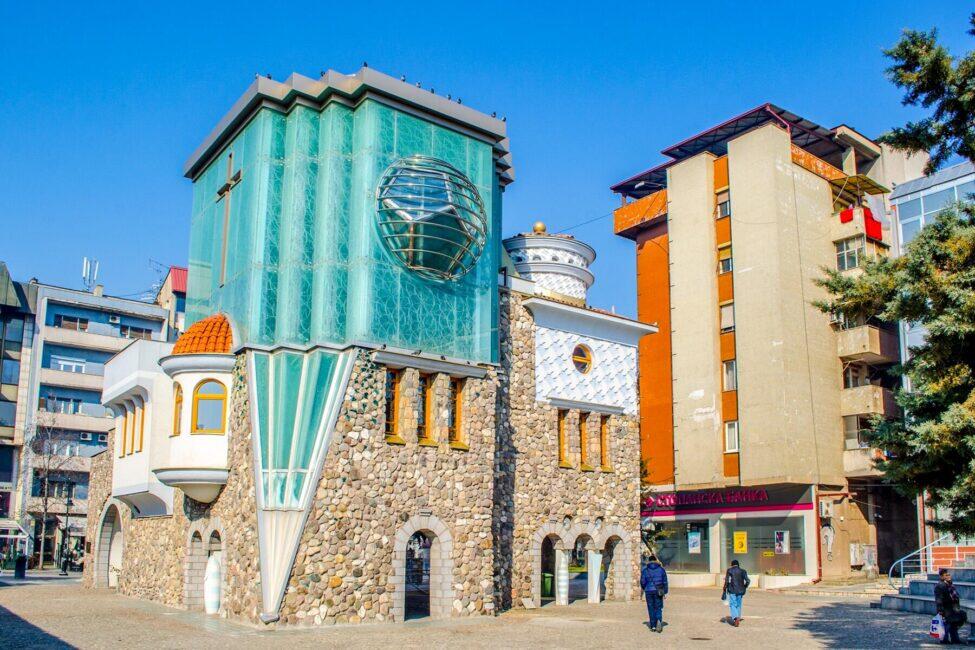
Delicious Balkan Delicacies
A particularly strong point are the restaurants. In the Debar Maalo district, 50 different eateries serve hearty Balkan dishes such as cow tongue, pig intestine, and fried lamb brain. The relaxed acoustic guitar vibes found here are replaced by a local form of turbo-folk if you go out of the center to places like La Pana, where groups of friends sit on circular tables nursing bottles of raki until, many hours later, they find themselves dancing on the chairs.
The city’s old bazaar is a hodgepodge of Ottoman and Byzantine styles built and rebuilt after several wars and earthquakes from the 12th century onwards. Rantasa Bojan, who runs bicycle tours around the city, suggests a type of double bread borek unique to Skopje called simit pogaca from a bakery in the bazaar’s basement.
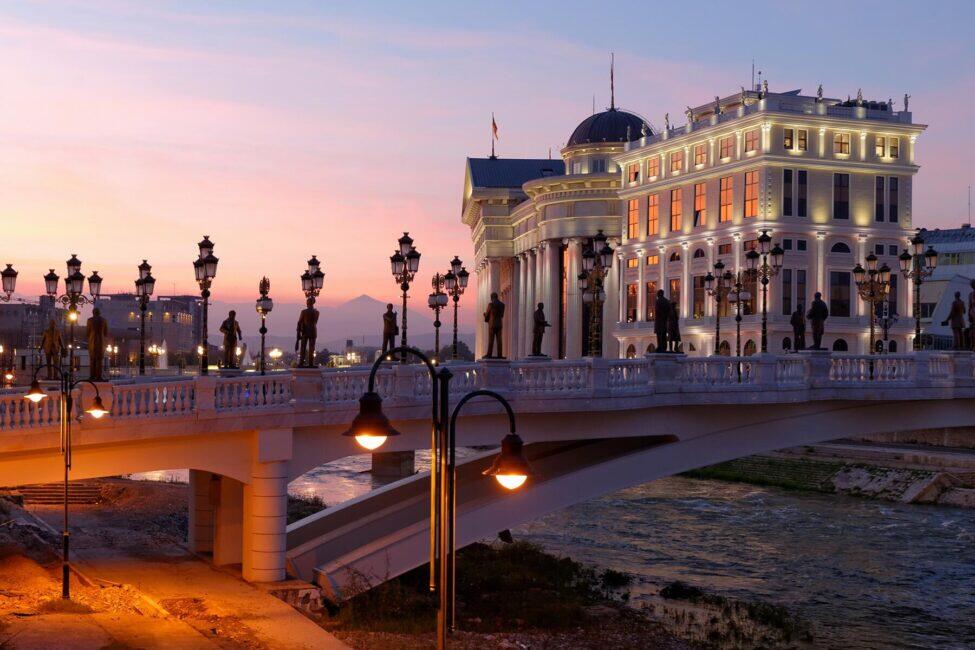
A City Formed by Geography
Geography has played more of a role in shaping life in Skopje than in most cities. One of the few silver linings to emerge from the rubble of the 1963 quake was a remodeling of it in favor of bikes. Now most boulevards have a lane, making it “the most bike-friendly city in the Balkans” according to Bojan, who admits those from Northern Europe may still blanche at some of the driving.
The city itself sits on a vast, flat plain surrounded by mountains. Hiking or catching a cable car to the top gives as good a view of the city as from the old fort on the hill or the rooftop bar of the Arka Hotel. Skopje is best visited in spring or autumn when the high summer temperatures don’t force the citizens inside for much of the day.
With sadness in his voice, Bojan admits that the heady days of incredibly loose licensing laws, which allowed bars to open all night and morning, have now gone. Since 2004, the club cut-off has been 3 a.m., worsening what the cling guides see as a regrettable part of Skopjan’s character.
“The problem in Skopje is the majority of people don’t dance. They stay stiff,” he says.
In the summer months several venues move into the central parks to provide a cooler, al-fresco version of clubbing that spills out beneath the trees and has a tendency of ignoring the curfew. When the music is playing and the stars shining above the branches here, it is easy to forget the crumbling city and the dust cloud of its politics that otherwise so pervades Skopje.
Perfect choice of representative dishes. It really shows the author’s refined taste and understanding of the local delices. Someone may think that the choice of the mentioned dishes is pretentious and malicious, trying to present the locals as drunken savage raki drinkers with mouths full of baby lamb brains dancing on the chairs around round tables. This is completely wrong interpretation of the authors idea, who, I am convinced, only has the best intention to dive deep into and reveal the fines secrets of the wonders of the Macedonian culinary tradition.
So sorry our ancestors didn't plunder half the world and for not being awarded with a western king and institutions like all of Macedonia's neighbors did in late 1800s. Do you see a pattern there or the point of the article is just to be sensationalist by way of ridiculing?
"Now most boulevards have a lane, making it “the most bike-friendly city in the Balkans” according to Bojan"
Is this some kind of joke, or is Bojan blind? In Skopje, most of the pedestrian or bicycle lanes are occupied by parked cars, so you cannot use them. Police don't give a s*it. Most of the people too. Bojan either was nowhere except Skopje and RNM, or I don't know what to say about this statement.....

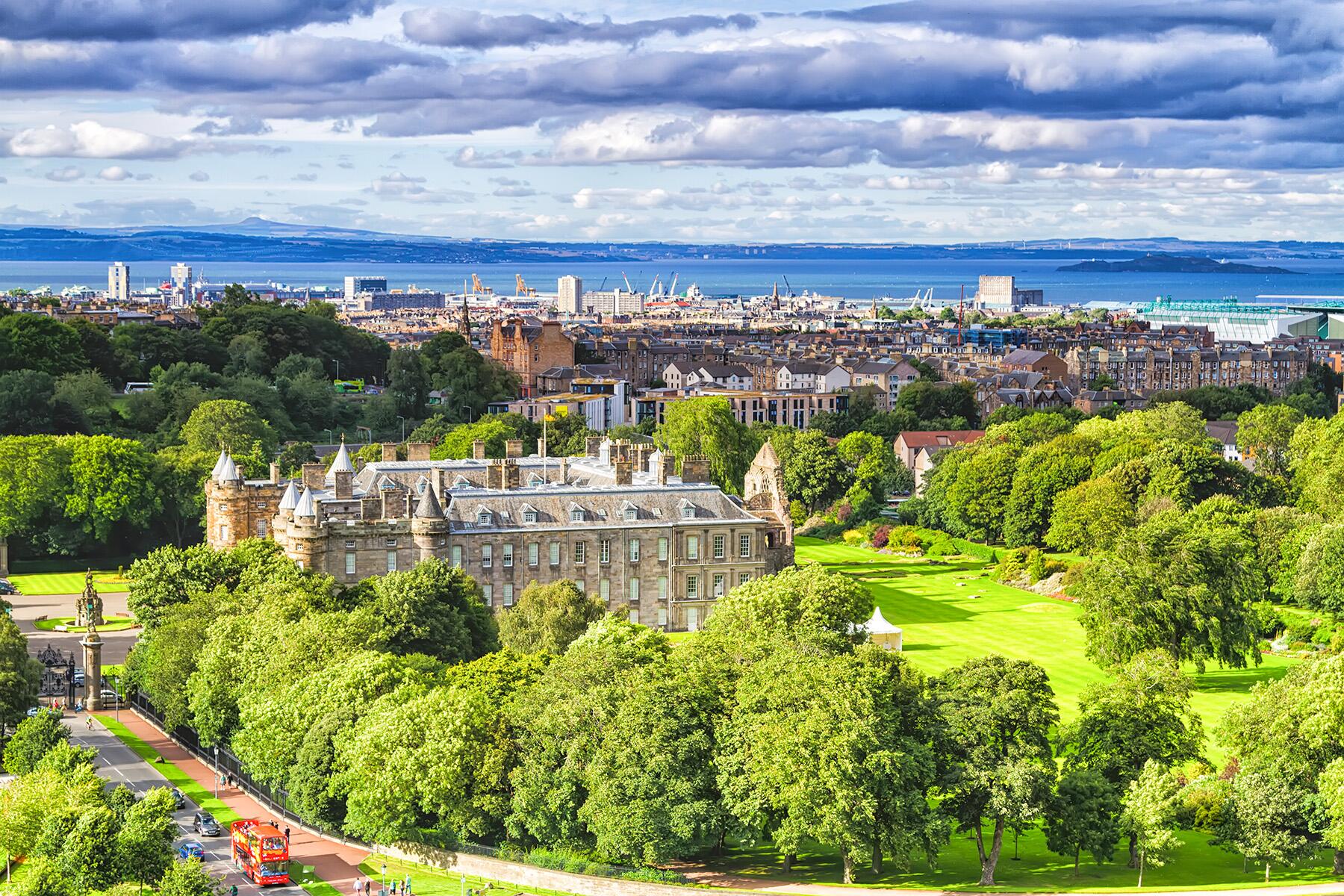
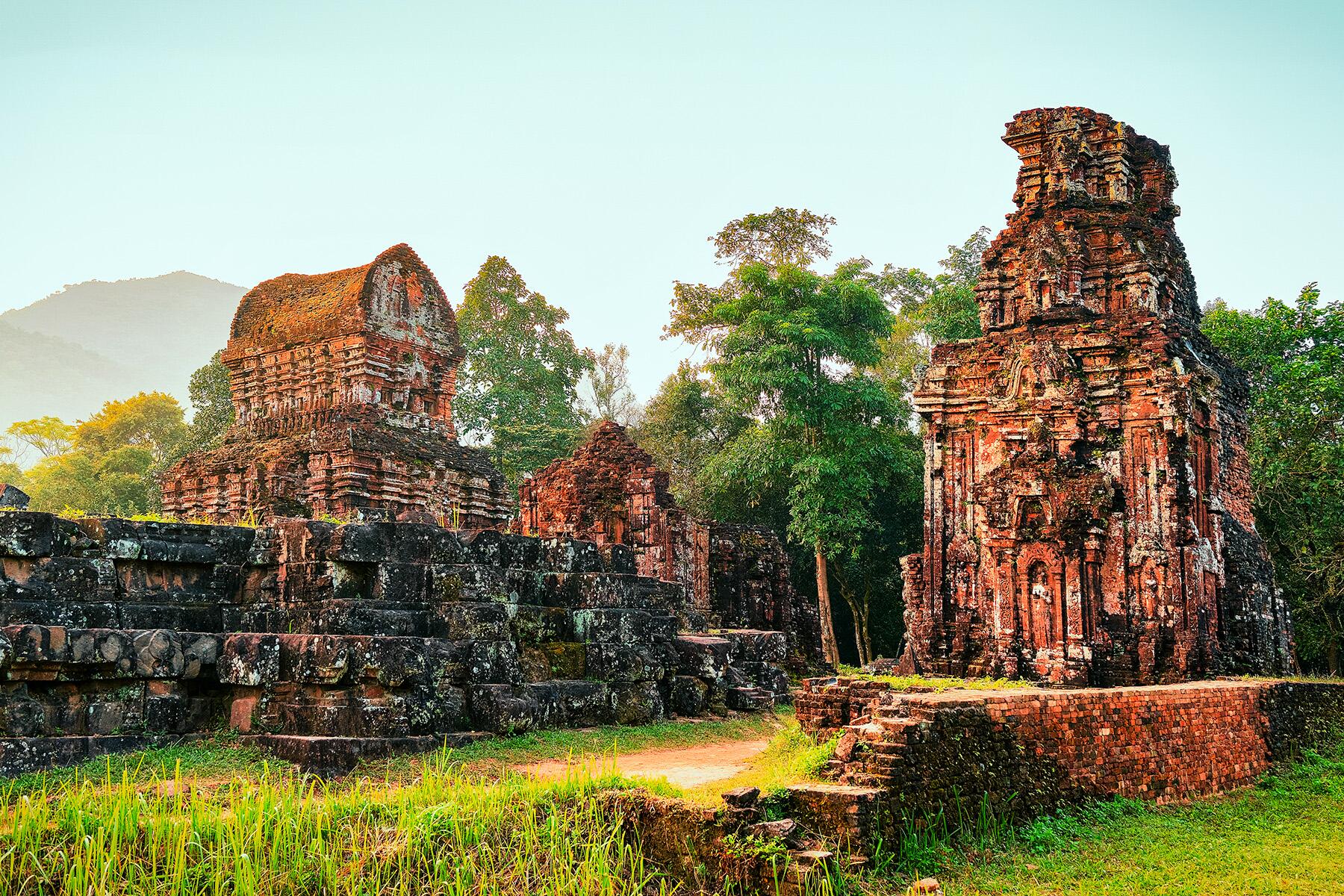

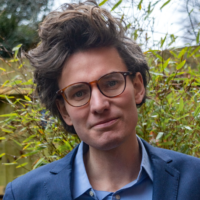
I am utterly disgusted by the author's pretentious commentary on Skopje and its cultural landscape. Their portrayal of the city's iconic statue as a "bronze middle finger," coupled with their dismissive attitude toward its architectural projects, showcases a profound lack of understanding and respect for the nuanced historical and cultural contexts of Skopje. To reduce the significance of these structures to mere distractions is not only ignorant but also disrespectful to the efforts and aspirations of the local community.Furthermore, the author's criticism of Skopje's cultural offerings, food being served at restaurants, and nightlife reflects a narrow-minded viewpoint that fails to appreciate the city's multifaceted identity and the experiences of its residents and visitors. By focusing solely on perceived shortcomings and trivializing the city's cultural richness, they undermine the genuine efforts of those who strive to showcase Skopje's heritage and vitality.It is appalling to see such disdainful commentary masquerading as legitimate critique. Skopje deserves better than this shallow and condescending portrayal.
Why do you feel it's condescending? Apparently many Macedonians strongly dislike the monuments too.